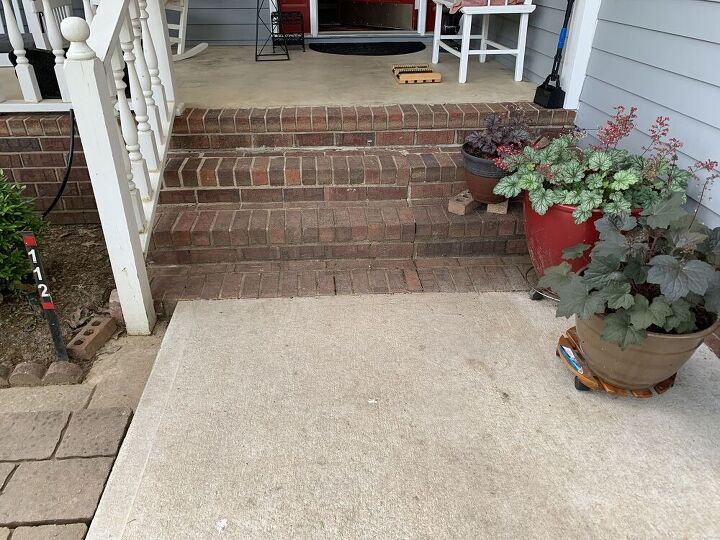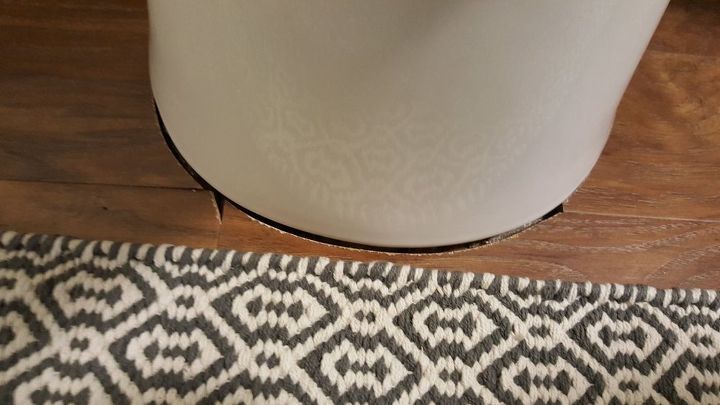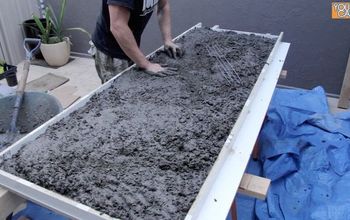How to create pitch/slope in a cured cement slab??

We have always had a problem with water pooling at the bottom of the front stairway (entry to our home) after it rains. Sometimes, 2-4 inches. My husband tried to fix it by pouring a slab and adding a French drainage system. Unfortunately, I think he forgot to make a pitch or slope in it. The problem is worse now with water accumulating at least 1/4 of the way down the sidewalk as well. There is no way to enter the house now when it rains except through the garage. To make the matter worse, our house is sloped somewhat down from street level .
Related Discussions
How to get rid of mice?
We seem to have some unwelcome Mickeys and Minnies in our house. What is the best way to get rid of them?
How to remove popcorn ceiling with asbestos?
I want to remove my popcorn ceiling, but it has asbestos in it. How do I go about this safely?
How to caulk baseboard gaps?
How do I fill gaps at baseboard, should I caulk? If so, does anyone know how to caulk baseboards?
How to fix squeaky hardwood floors?
How do I fix squeaky hardwood floors?
Tile backsplash when there is existing countertop backsplash
We are thinking about how to add a backsplash to our kitchen. Unfortunately when we had our countertops installed we ordered a small backsplash that comes part way up... See more
Contractor mis-cut the floor when he put in the toilet
Hello, Our contractor didn't "measure twice, cut once" when he put in our toilet. Check out the photo. I'd appreciate any suggestions on a fix or a way to hide this m... See more











This can be a complex fix - which you've learned. I would call in several experts and have your husband "play dumb" while wringing them for info.
Hello. Gosh this looks like a frustrating and complex situation. One question I wanted to ask was are your gutters buried and extend it out into your yard? If they just end at your foundation line the excessive water running off your roof could be impacting this situation greatly. Something to think about.
To Vim's point, where is the water coming from? You mentioned the walkway is pitched downward from the street to the house, but the new slab raises it up a step. It looks like your lawn is below or level with the walkway. Is water coming off the roof? Down the walk? Running in from the yard? Where does the French drain drain to? Need a little more info to give you a more specific solution.
I found this and it looks like a lot of work, but my be worth it and a good solution for your problem: https://www.youtube.com/watch?v=D1IvGH-gUDY
Get some gutter extensions at Lowes or HD. That will greatly ease the water problem. Other than that you may need a contractor to fix the added slab problem. Sloping is extremely important and it may need to be redone. A mess I know.
If he forgot to slope the French drain sufficiently, then excavate it and change that.
Is the slope of the new concrete pad also not sufficient? Can you grind drainage lines or a chamfer edge with an angle grinder?
Yes, check your gutter's slope.
I've had to abandon the under-ground downspout drain systems on my past two houses.
Your property needs to be able to handle the amount of stormwater and rainfall it receives, so extra water doesn’t cause costly damage.
There are a variety of solutions, depending on the exact problem and the characteristics of your property.
Sometimes, a combination of solutions is the best plan.
Here’s a look at some options:
1. Dry CreeksThis is a subtle and creative solution for backyard drainage issues that offers a bonus: it’s pretty.
A shallow trough is lined with stones or rocks, offering excess water a place to flow and runoff.
2. Trench DrainsThis is a great choice for heavily paved areas, such as walkways and parking lots. Trench drains are concrete-lined channels that help direct water flow while filtering out debris using grates or filters to reduce clogging.
3. French DrainsOne of the more intricate methods of controlling water flow around a building or property is by using French drains.
These are typically perforated pipes that channel water in a specific direction. These pipes are usually covered with rocks and gravel to help with filtration, water flow and ensure that the pipes stay in place.
French drains are the go-to choice for preventing flooded basements.
4. Site GradingSite grading involves changing the landscape to encourage water to flow in the desired direction — away from the house.
Many drainage issues stem from improper grading techniques during a home or building’s construction.
5. Dry Wells & ReservoirsWhen surface water has no place to go, it pools and floods. Building a dry well underground, or a reservoir on the surface gives excess water a home.
I found this info for you
https://www.doityourself.com/stry/how-to-slope-a-concrete-patio-for-drainage
https://www.hunker.com/12598284/problems-with-concrete-patio-drainage
What if you cut a small trench between the brick & slab? Then you will have a way for the water to escape.
You can grind concrete with a angle grinder and a diamond disk..
this may help https://www.nachi.org/roof-slope-pitch.htm
You have many different materials and surfaces, some of which appear to be trip hazards due to the gaps and drop offs. The fact that the ledges and heights do not match up is certainly not the safest situation to have near steps. It also appears that the entire brick step area is sinking and shifting.
The answer is not to continue trying to add more materials in attempt to patch up individual areas. This will only intensify the retention of water and erosion of the earth under the concrete and bricks.
The solution is to tear everything out, have the entire area regraded and new concrete, or paving stones installed.
I agree with Flipturn. The more you add, the worse things are going to get, especially if slopes are missing and more impervious materials are added. While it'll be a pain, ripping it out, re-grading, and starting over is really the only true solution.
I would contact a repair person
How about Duckboards!
If you can imagine a Pallet only smaller scale on the ground allowing you to walk through water without getting your feet wet!